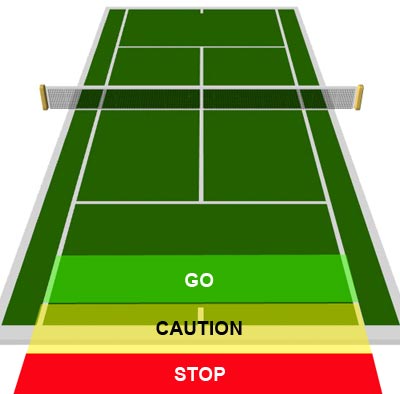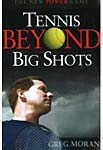| TennisOne Lessons Meet the Approach Shot Greg Moran There’s an old singles saying that tells us that “the point doesn’t begin until someone hits a short ball. As with most old sayings, there’s an element of truth to this.
A typical singles point at the recreational level goes something like this: One player serves, the other returns the serve and then both players exchange groundstrokes. Assuming neither player commits an error, one eventually hits a short ball. The other player then moves forward and attacks the short ball in an attempt to take control of the point. In today’s power obsessed game, many players view this short ball as an opportunity to flex their tennis muscles. They move forward, take a huge swing at the ball and frequently deposit it into the net, or the next court. For those you that have grown up watching Rafael Nadel and Maria Sharapova hit winners for all areas of the court., an approach shot is a transition shot that first, puts your opponent in a defensive position and then sets you up to win the point with a volley or overhead. Here’s how to hit it: Seize the Opportunity
As you exchange groundstrokes with your opponent, you’re looking for that ball that will allow you to begin to dictate the action. A good way to decide when to attack is to divide the tennis court into sections using a traffic-light motif. The area behind, the baseline is the red light; the area between the baseline and service line is the yellow light; and the area from the service line to the net is the green light. If you are standing in the red zone to hit the ball, STOP! Stay back, hit a groundstroke and wait for a better opportunity. If you are standing in the yellow zone, proceed with CAUTION! The ball may be short enough to attack, but you may not be able to hit a strong enough approach shot or get close enough to the net to volley effectively. If you are standing in the green zone to hit the ball, GO! You’ve got a green light, so hit your approach and get to the net. Experienced players have learned to anticipate a short ball from their opponent a shot or two before it actually occurs. They understand that what causes a player to hit short is basically one of two things: either a strong shot by them or a weak stroke by their opponent. If you know that Bill hasn’t hit a strong backhand in the last 10 years, and you put a deep shot into his backhand corner, get ready to rumble. Or, if you get a soft floater that bounces up about waist high into your strike zone, hit a firm shot and look for the short reply. In fact, any time you hit a shot that makes your opponent scramble, take a quick step or two inside the baseline in anticipation. Yes, I know you’re now standing on the edge of the dreaded “no-man’s land,” but that’s okay. The danger of standing in “no-mans land” is that your opponent will drive a hard shot down at your feet or past you. However, when he’s stretched out, off-balance or on the run the chances of this are slim. His return will most likely be weak, and you can then attack with an approach shot or volley.
Jump on it As with any shot in tennis, the key to hitting an effective approach shot is a quick first step. As soon as you recognize that your opponent’s shot will be landing short in the court (somewhere around the service line) Take a quick step forward and prepare your racquet, using a slightly shorter backswing. Be sure you get up to the ball quickly, before it has a chance to drop too low. As you approach the ball, turn sideways and plant your back foot. Then, step forward with your front foot, swing and move through the ball Use a long follow through and be sure to keep your wrist firm. Do not stop to hit your approach shot. As you strike the ball, keep your feet moving through the shot and continue coming to the net. (On a backhand approach shot, you have to cross your back foot behind your front in a step called a carioca to continue moving forward). By hitting on the move, you’ll cover more ground and get closer to the net before your opponent can strike the ball. Be careful, however, not to over-hit your approach shot. The added force from your forward momentum can easily make you hit the ball long. A short backswing and controlled stroke will help you keep the ball in. If you’re having trouble moving through the ball on the approach shot, stop to hit it before moving forward again. It can be challenging to move through the shot without running into it. After you become more comfortable, you’ll get the footwork down and be able to move through the shot. I also suggest putting slice on your approach shot by swinging with a high to low motion. Slice will help the ball stay low after the bounce. This will force your opponent to hit “up” to clear the net, giving you an easier volley. Slice also moves through the air slower than a ball hit flat or with topspin, so you’ll have a bit more time to move into a better net position. Remember, the harder you hit your approach shot, the faster it gets to your opponent--which means the faster it’s going to come back at you.
The slice approach is one of my favorite shots in doubles against a team that has taken control of the net. When I get the short ball, I love to move up and hit a soft slice down the middle or at their feet and then follow it in to the net. The slower moving soft slice gives me time to move in, plus the ball drops below the level of the net which means that my opponents have to hit “up” to me. Of course, I’m salivating as I move in and prepare to volley away their high return. Don’t Try to End the Point. Your top priority with the approach shot is to hit it in the court. Of course you want to hit a forcing shot, but even the shortest, weakest approach shot is better than an error because your opponent still has to hit the ball to beat you. So your number one goal on an approach shot is to get it in. Down the line is the high percentage placement for singles. After that, strive for depth. A short approach shot is an invitation for your opponent to pass you. Don’t aim for the lines, but target an area a few feet inside for safety. A deep approach shot will immediately put your opponent on their heels and you can then pounce on their weak reply. The next time you’re faced with a short ball from your opponent, pull back the reigns a bit. Execute a solid approach shot, move to the net and I think you’ll find that a lot more points will be ending in your favor. Your comments are welcome. Let us know what you think about Greg Moran's article by emailing us here at TennisOne.
Tennis Beyond Big Shots presents a bold back-to-the-future approach. A new game that moves away from power and big shots yet is more lethal to opponents than any booming serve. Greg Moran shows players of all ages and abilities that, with simple and small changes, you can not only maximize your tennis wins and play longer, but also have much more fun doing it. Click link to purchase Greg Moran's book, Tennis Beyond Big Shots. Mansion Grove House is pleased to announce that in May, 2008, they will release the second edition of Tennis Beyond Big Shots. Written by Greg Moran, the book (which includes a new chapter) was Amazon's #1 new tennis release in 2007. |

